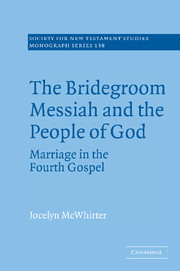Book contents
- Frontmatter
- Contents
- Acknowledgments
- List of abbreviations
- 1 Allusions to biblical texts about marriage
- 2 Echoes of Scripture, representative figures, and messianic exegesis
- 3 The revelation of the bridegroom-Messiah: allusions to Jeremiah 33:10–11 and Genesis 29:1–20
- 4 The glorification of the bridegroom-Messiah: allusions to Song 1:12 and Song 3:1–4
- 5 The bridegroom-Messiah of Psalm 45 in the Song of Songs, Jeremiah 33:10–11, and Genesis 29:1–20
- 6 Hearing the echoes
- 7 Conclusion
- Bibliography
- Scripture index
- Index of ancient commentators
- Index of modern commentators
3 - The revelation of the bridegroom-Messiah: allusions to Jeremiah 33:10–11 and Genesis 29:1–20
Published online by Cambridge University Press: 22 September 2009
- Frontmatter
- Contents
- Acknowledgments
- List of abbreviations
- 1 Allusions to biblical texts about marriage
- 2 Echoes of Scripture, representative figures, and messianic exegesis
- 3 The revelation of the bridegroom-Messiah: allusions to Jeremiah 33:10–11 and Genesis 29:1–20
- 4 The glorification of the bridegroom-Messiah: allusions to Song 1:12 and Song 3:1–4
- 5 The bridegroom-Messiah of Psalm 45 in the Song of Songs, Jeremiah 33:10–11, and Genesis 29:1–20
- 6 Hearing the echoes
- 7 Conclusion
- Bibliography
- Scripture index
- Index of ancient commentators
- Index of modern commentators
Summary
The Fourth Evangelist's first concern is to introduce Jesus. His opening chapters involve both explaining who Jesus is and describing how people respond to him. The prologue (1:1–18) sets this two-part agenda. It begins by identifying Jesus as “the Word” (1:1, 14) and “the light” (1:4–9). It then turns to the messianic designation “Christ” (1:17), but not before characterizing human response to Jesus:
He was in the world, and the world came into being through him; yet the world did not know him. He came to what was his own, and his own people did not accept him. But to all who received him, who believed in his name, he gave power to become children of God, who were born, not of blood or of the will of the flesh or of the will of man, but of God. And the Word became flesh and lived among us, and we have seen his glory, the glory as of [the Father's only Son], full of grace and truth.
(1:10–14)Subsequent stories follow the agenda set in the prologue. When Jesus appears on the scene in 1:29–51, John adds further revelations of his identity and begins to describe his encounters with various people. Initially, the response to Jesus is quite positive. People begin to recognize that he is the Messiah. John the Baptist confesses, “I am not the Messiah” (1:20), and then goes on to suggest that Jesus is (1:26–34).
- Type
- Chapter
- Information
- The Bridegroom Messiah and the People of GodMarriage in the Fourth Gospel, pp. 46 - 78Publisher: Cambridge University PressPrint publication year: 2006



